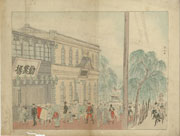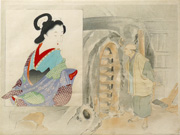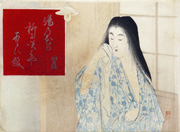Prints in Collection
Wankyu Monogatari, 1900
IHL Cat. #532
After the Bath, 1901
IHL Cat. #531
Biography

photo c. 1887
Given name: Takeuchi Ginpei. Born in the Akasaka district in Edo, he was the second son of a retainer of the Kishū daimyo. The name Keishū was given to him by Keika-en Keika, a haiku poet and friend of his father. He received no formal education. He is primarily known as an illustrator.
Keishū was adopted into the family of Kanō Eitoku (1814-1891), who was head of the prestigious Nakabashi Kanō lineage. But, because of the chaos in the country, there was no work for Kanō1 painters so Keishū worked as a porcelain painter while studying Kanō. After the suicide of his elder brother in 1879 or 1880, he returned to his father's house and abandoned the Kanō style. After a disagreement about quality, Keishū switched from porcelain painting to making hanshita (drawing the black line images to be used for the keyblocks for woodblock prints.)
At some point he studied drawing under Karino Masanobu and Tsukioka Yoshitoshi (1839-1892).
It is not known when Keishū began illustration. According to Keishū, his early years as a hanshita artist paid little and he was often hard-pressed for basic necessities. When his son mentioned a desire to become a painter, Keishū responded, "If you are able to live on air and water, you may become an artist."
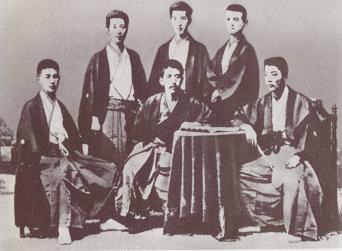 Photo, Friends of the Inkstone c. 1887 http://shisly.cocolog-nifty.com/blog/2009/10/post-0048.htmlFront row from the left: Sazanami Iwaya, Shian Ishibashi,Kōyō Ozaki Back row from the left: Keishū Takeuchi, Bizan Kawakami, Suiin Emi | In 1887, he joined the writing society Ken'yūsha (Friends of the Inkstone - a literary coterie founded in 1885 by a group of Tokyo University students) and designed kuchi-e (woodblock-printed frontispiece illustrations produced for publication in Japanese novels and literary magazines) and sashi-e (illustrations in books, magazines, and newspapers) for the novels of many of its members including its leader Ozaki Kōyō (1868-1903). He became the art editor for the Bungei Kurabu literary magazine and contributed some sixty-five kuchi-e, several of which are part of this collection. Takeuchi was such a good friend of Ozaki Kōyō that he drew theillustrations for Ozaki’s outstanding work, Konjiki Yasha (The Gold Demon), and hefrequented the exclusive restaurant Koyokan (The Maple Club) in Shiba Park with theinner group members of Kenyūsha, Sazanami Iwaya (1870-1933), ShianIshihashi, Bizan Kawakami (1869-1908), and Ozaki Kōyō, who claimed that Koyokan |
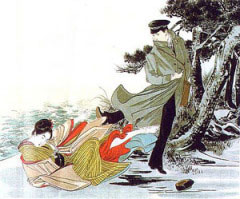
Keishū's produced woodblocks through the Russo-Japanese War. In his later years he devoted himself to making and collecting dolls. In 1937 he was honored by the mother of Emperor Shōwa who requested that he paint a picture of court dolls for her.
1 Source: The British Museum website http://www.britishmuseum.org/explore/highlights/article_index/j/japanese_painting_kan%C5%8D_school.aspx The Kanō school of painters were professional artistspatronized by the shogunate from the late Muromachi period(1333-1568). The school was founded by Kanō Masanobu (1434-1530)who trained in ink painting of the Chinese Southern Song and Yuandynasties at Shōkokuji Temple in Kyoto. Originally this inkpainting style had been practiced mainly by Zen painter-monks as away to enlightenment, but the Kanō artists became dominant, throughthe patronage of the Ashikaga shoguns (1338-1573). They werestrictly secular professionals who worked mainly for the shogunateas official painters of Kanga over the next 400 years.
Latest revision: